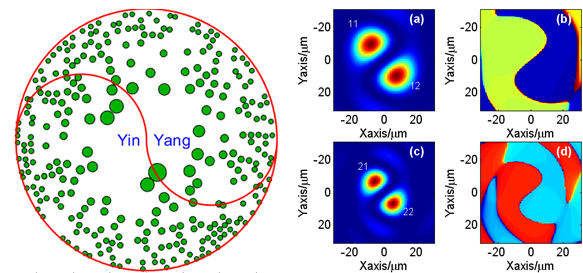
With the development of the next generation of synchrotron radiation and free electron lasers in recent years, x-ray measurement and imaging, such as X-ray holography and biochemical microscopy, becomes a hot spot again. However, traditional phase shifters cannot be used in the region of x-ray due to the strong absorption of material, which has greatly hindered the development speed. Based on previous discovery, in 1965 the common-path lensless Fourier-transform x-ray holography was proposed and applied for imaging phase-only object.
Recently, researchers at Shanghai Institute of Optics and Fine Mechanics, Chinese Academy of Sciences, have introduced the concept of Yin and Yang of Chinese Taiji diagram into diffractive lenses and successfully constructed a kind of phase-shifting three-dimensional focal spots, which can be used for lensless Fourier-transform x-ray holography.
Three thousand years ago, Chinese Taiji suggested the law of the unity of opposites. Now the diffraction competition of Yin and Yang can be used to generate multiple phase-shifting focal spots, which are located at the object plane in order to realize phase-shifting lensless Fourier-transform x-ray holography.
In the following experiment, they designed the amplitude-only Taiji lens and used them to image a 1951 U.S. Air Force resolution test target and a vortex focal spot. The experimental results agree well with the theoretical analysis and verify the validity of the phase shift function of Chinese Taiji lens.
In developing the next generation of synchrotron light source (free-electron lasers), the amplitude-only Taiji lens will offer an opportunity for x-ray holography, biochemical microscopy at short wavelengths, and x-ray spectroscopy in physical and life sciences.
This research, entitled "Phse-shifting lensless Fourier-transfrom holography with a Chinese Taiji lens" has been published in Optics Letters on August 17, 2018.
This work was supported by the National Natural Science Foundation of China and Youth Innovation Promotion Association of the Chinese Academy of Sciences.

Schematic of Chinese Taiji lens and its bilayer phase-shifting focal spots (a, c) intensity, (b, d) phase. (Image by Dr. ZHANG Junyong's lab)

86-10-68597521 (day)
86-10-68597289 (night)

52 Sanlihe Rd., Xicheng District,
Beijing, China (100864)

